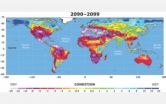(Press-News.org) The United States and many other heavily populated countries face a growing threat of severe and prolonged drought in coming decades, according to results of a new study by National Center for Atmospheric Research (NCAR) scientist Aiguo Dai.
The detailed analysis concludes that warming temperatures associated with climate change will likely create increasingly dry conditions across much of the globe in the next 30 years.
The drought may reach a scale in some regions by the end of the century that has rarely, if ever, been observed in modern times.
Using an ensemble of 22 computer climate models and a comprehensive index of drought conditions, as well as analyses of previously published studies, the paper reports that by the 2030s, dryness is likely to increase substantially across most of the Western Hemisphere, along with large parts of Eurasia, Africa, and Australia.
By later this century, many of the world's most densely populated regions will be threatened with severe drought conditions.
In contrast, higher-latitude regions from Alaska to Scandinavia are likely to become more moist.
Dai cautioned that the findings are based on the best current projections of greenhouse gas emissions.
What happens in coming decades will depend on many factors, including actual future emissions of greenhouse gases as well as natural climate cycles such as El Niño.
The new findings appear this week as part of a longer review article in Wiley Interdisciplinary Reviews: Climate Change. The study was supported by the National Science Foundation (NSF), NCAR's sponsor.
"This research does an excellent job of placing future warming-induced drought in the context of the historical drought record," says Eric DeWeaver, program director in NSF's Division of Atmospheric and Geospace Sciences, which funds NCAR.
"The work argues credibly that the worst consequences of global warming may come in the form of reductions in water resources."
While regional climate projections are less certain than those for the globe as a whole, Dai's study indicates that most of the western two-thirds of the United States will be significantly drier by the 2030s.
Large parts of the nation may face an increasing risk of extreme drought during the century.
"We are facing the possibility of widespread drought in the coming decades, but this has yet to be fully recognized by both the public and the climate change research community," Dai says. "If the projections in this study come even close to being realized, the consequences for society worldwide will be enormous."
Other countries and continents that could face significant drying include:
Much of Latin America, including large sections of Mexico and Brazil
Regions bordering the Mediterranean Sea, which could become especially dry
Large parts of Southwest Asia
Most of Africa and Australia, with particularly dry conditions in regions of Africa
Southeast Asia, including parts of China and neighboring countries
The study also finds that drought risk can be expected to decrease this century across much of Northern Europe, Russia, Canada, and Alaska, as well as some areas in the Southern Hemisphere.
However, the globe's land areas should be drier overall.
"The increased wetness over the northern, sparsely populated high latitudes can't match the drying over the more densely populated temperate and tropical areas," Dai says.
Previous climate studies have indicated that global warming will probably alter precipitation patterns as the subtropics expand.
The 2007 assessment by the Intergovernmental Panel on Climate Change (IPCC) concluded that subtropical areas will likely have precipitation declines, with high-latitude areas getting more precipitation.
In addition, previous studies by Dai have indicated that climate change may already be having a drying effect on parts of the world.
He and colleagues found that the percentage of Earth's land area stricken by serious drought more than doubled from the 1970s to the early 2000s. Last year, he headed up a research team that found that some of the world's major rivers are losing water.
In his new study, Dai turned from rain and snow amounts to drought itself, and posed a basic question: how will climate change affect future droughts?
If rainfall runs short by a given amount, it may or may not produce drought conditions, depending on how warm it is, how quickly the moisture evaporates, and other factors.
Droughts are complex events that can be associated with significantly reduced precipitation, dry soils that fail to sustain crops, and reduced levels in reservoirs and other bodies of water that can imperil drinking supplies.
A common measure called the Palmer Drought Severity Index classifies the strength of a drought by tracking precipitation and evaporation over time and comparing them to the usual variability one would expect at a given location.
Dai turned to results from the 22 computer models used by the IPCC in its 2007 report to gather projections about temperature, precipitation, humidity, wind speed, and Earth's radiative balance, based on current projections of greenhouse gas emissions.
He then fed the information into the Palmer model to calculate the PDSI index. A reading of +0.5 to -0.5 on the index indicates normal conditions, while a reading at or below -4 indicates extreme drought.
The index ranges from +10 to -10 for current climate conditions, although readings below -6 are exceedingly rare, even for small areas.
By the 2030s, the results indicated that some regions in the United States and overseas could experience particularly severe conditions, with readings potentially dropping to -4 to -6 in much of the central and western United States as well as several regions overseas, and -8 or lower in parts of the Mediterranean.
By the end of the century, many populated areas, including parts of the United States, could face readings in the range of -8 to -10, and much of the Mediterranean could fall to -15 to -20.
Such readings would be almost unprecedented.
Dai cautions that global climate models remain inconsistent in capturing precipitation changes and other atmospheric factors, especially at the regional scale.
However, the 2007 IPCC models were in stronger agreement on high- and low-latitude precipitation than those used in previous reports, says Dai.
There are also uncertainties in how well the Palmer index captures the range of conditions that future climate may produce.
The index could be overestimating drought intensity in the more extreme cases, says Dai.
On the other hand, the index may be underestimating the loss of soil moisture should rain and snow fall in shorter, heavier bursts and run off more quickly.
Such precipitation trends have already been diagnosed in the United States and several other areas over recent years, says Dai.
"The fact that the current drought index may not work for the 21st century climate is itself a troubling sign," Dai says.
INFORMATION:
Drought may threaten much of globe within decades
Dryness likely to increase substantially across Eurasia, Africa, Australia
2010-10-20
ELSE PRESS RELEASES FROM THIS DATE:
Study reveals superior sedation method for children
2010-10-20
Procedural sedation and analgesia is an essential element of care for children requiring painful procedures in the emergency department. The practice of combining ketamine and propofol, two common medications used in emergency departments, has become more popular. However, until recently, it was unclear whether this practice was superior to the use of either agent alone, especially in children.
Research led by Drs. Amit Shah, Gregory Mosdossy and Michael Rieder of the Schulich School of Medicine & Dentistry at The University of Western Ontario and Lawson Health Research ...
Iowa State, USDA researchers discover eye test for neurological diseases in livestock
2010-10-20
AMES, Iowa – The eyes of sheep infected with scrapie – a neurological disorder similar to mad cow disease – return an intense, almost-white glow when they're hit with blue excitation light, according to a research project led by Iowa State University's Jacob Petrich.
The findings suggest technologies and techniques can be developed to quickly and noninvasively test for transmissible spongiform encephalopathies, progressive and fatal neurological diseases such as mad cow disease in cattle and Creutzfeldt-Jakob disease in humans. Petrich, in fact, is working to develop ...
Old logging practices linked to high erosion rates
2010-10-20
Clear-cut logging and related road-building in the 1950s and 1960s in southern Oregon's Siskiyou Mountains disrupted soil stability and led to unprecedented soil erosion made worse during heavy rainstorms, report University of Oregon researchers.
While logging practices have improved dramatically since then, the damaged landscape -- the removal of low vegetation that helps to protect hillsides during fires and rain -- continues to pose a threat into the foreseeable future, said Daniel G. Gavin, professor of geography, and postdoctoral doctoral researcher Daniele Colombaroli.
Their ...
The hair brush that reads your mind
2010-10-20
WASHINGTON, Oct. 19 – One of the main techniques for measuring and monitoring mental activity, called functional near infrared spectroscopy (fNIRS), can often be impaired because a person's hair gets in the way. But now, thanks to a team of researchers at the University of Texas at Dallas and the University of Texas at Arlington, a novel device called a "brush optrode" is providing increased sensitivity with fiber tips designed to thread through hair to enhance scalp contact.
Details of the device will be presented at the Optical Society's (OSA) 94th annual meeting, ...
Researchers advocate for more education and attention regarding rare breast cancer
2010-10-20
PHILADELPHIA (October 19, 2010)—Inflammatory breast cancer (IBC), an aggressive and rare malignancy, is often initially misdiagnosed as an infection or rash. However, getting the correct diagnosis quickly is critical for patients because the disease spreads beyond the breast in a matter of just days or weeks. With that in mind, leading specialists from The University of Texas MD Anderson Cancer Center and Fox Chase Cancer Center have written a review of the current scientific and medical understanding of IBC, which includes key information on diagnosis, imaging, treatment, ...
ORNL's research reactor revamps veteran neutron scattering tool
2010-10-20
OAK RIDGE, Tenn., Oct. 19, 2010 -- The Cold Triple Axis spectrometer, a new addition to Oak Ridge National Laboratory's High Flux Isotope Reactor and a complementary tool to other neutron scattering instruments at ORNL, has entered its commissioning phase.
The CTAX uses "cold" neutrons from the HFIR cold source to study low-energy magnetic excitations in materials. Cold neutrons are slower than their "thermal" neutron counterparts, and thus perfect for probing low-energy dynamics.
The instrument, which moves by way of air pads on an epoxy surface known as the "dance ...
Study: Religious diversity increases in America, yet perceptions of Christian nation intensify
2010-10-20
WEST LAFAYETTE, Ind. - While America continues to become more religiously diverse, the belief that America is a Christian nation is growing more intense, according to research from Purdue University.
"America is still predominantly Christian, but it is more diverse than ever," said Jeremy Brooke Straughn, an assistant professor of sociology who studies national identity. "At the same time, many people feel even more strongly that America is a Christian country than they did before the turn of the century. This is especially true for Americans who say they are Christians ...
WSU and ASU professors urge one-way Martian colonization missions
2010-10-20
PULLMAN, Wash. - For the chance to watch the sun rise over Olympus Mons, or maybe take a stroll across the vast plains of the Vastitas Borealis, would you sign on for a one-way flight to Mars?
It's a question that gives pause to even Dirk Schulze-Makuch, a Washington State University associate professor, who, with colleague Paul Davies, a physicist and cosmologist from Arizona State University, argues for precisely such a one-way manned mission to Mars in an article published this month in the "Journal of Cosmology."
In the article, "To Boldly Go: A One-Way Human Mission ...
10-minute plasma treatment improves organic memory performance
2010-10-20
Washington, D.C. (October 19, 2010) -- In its current early stage of development, digital memory circuits that use organic elements instead of silicon or other inorganic materials have a seemingly endless list of variables and options to consider, test, and optimize. While organic electronics are immediately attractive for their potential for extremely low cost and flexible substrates, many design aspects that are now taken for granted in the mature silicon-circuit world must be examined anew from the ground up.
A group led by Takhee Lee from Korea's Gwangju Institute ...
Get in synch -- or be enslaved by it
2010-10-20
Washington, D.C. (October 19, 2010) -- We talk about synchronization a lot. We synch up; synch our computers; and get in synch. And synchronous behavior underlies many natural systems, events and phenomena.
Understanding conditions that cause oscillators -- which are common electronic components that produce a repetitive electronic signal -- to get in synch or fall out of synch, is necessary to achieve the optimal functioning of oscillator networks that underlie many technologies. The transition from synchronization to desynchronization is the subject of a new investigation ...
LAST 30 PRESS RELEASES:
Research alert: Spreading drug costs over the year may ease financial burden for Medicare cancer patients
Hospital partnership improves follow up scans, decreases long term risk after aortic repair
Layered hydrogen silicane for safe, lightweight, and energy-efficient hydrogen carrier
Observing positronium beam as a quantum matter wave for the first time
IEEE study investigates the effects of pointing error on quantum key distribution systems
Analyzing submerged fault structures to predict future earthquakes in Türkiye
Quantum ‘alchemy’ made feasible with excitons
‘Revoice’ device gives stroke patients their voice back
USF-led study: AI helps reveal global surge in floating algae
New method predicts asthma attacks up to five years in advance
Researchers publish first ever structural engineering manual for bamboo
National poll: Less than half of parents say swearing is never OK for kids
Decades of suffering: Long-term mental health outcomes of Kurdish chemical gas attacks
Interactional dynamics of self-assessment and advice in peer reflection on microteaching
When aging affects the young: Revealing the weight of caregiving on teenagers
Can Canada’s health systems handle increased demand during FIFA World Cup?
Autistic and non-autistic faces may “speak a different language” when expressing emotion
No clear evidence that cannabis-based medicines relieve chronic nerve pain
Pioneering second-order nonlinear vibrational nanoscopy for interfacial molecular systems beyond the diffraction limit
Bottleneck in hydrogen distribution jeopardises billions in clean energy
Lung cancer death rates among women in Europe are finally levelling off
Scientists trace microplastics in fertilizer from fields to the beach
The Lancet Obstetrics, Gynecology, & Women’s Health: Taking paracetamol during pregnancy does not increase risk of autism, ADHD or intellectual disabilities, confirms new gold-standard evidence review
Taking paracetamol during pregnancy does not increase risk of autism, ADHD or intellectual disabilities
Harm reduction vending machines in New York State expand access to overdose treatment and drug test strips, UB studies confirm
University of Phoenix releases white paper on Credit for Prior Learning as a catalyst for internal mobility and retention
Canada losing track of salmon health as climate and industrial threats mount
Molecular sieve-confined Pt-FeOx catalysts achieve highly efficient reversible hydrogen cycle of methylcyclohexane-toluene
Investment in farm productivity tools key to reducing greenhouse gas
New review highlights electrochemical pathways to recover uranium from wastewater and seawater
[Press-News.org] Drought may threaten much of globe within decadesDryness likely to increase substantially across Eurasia, Africa, Australia


